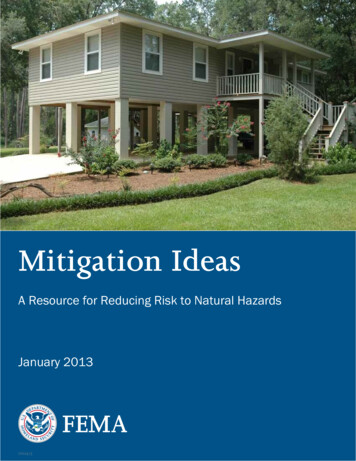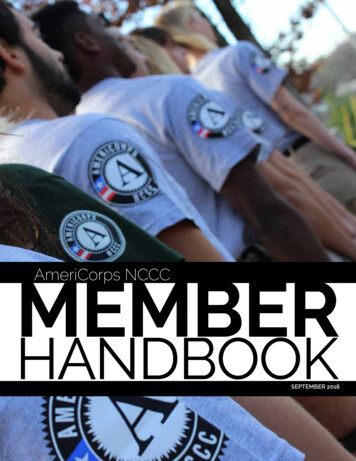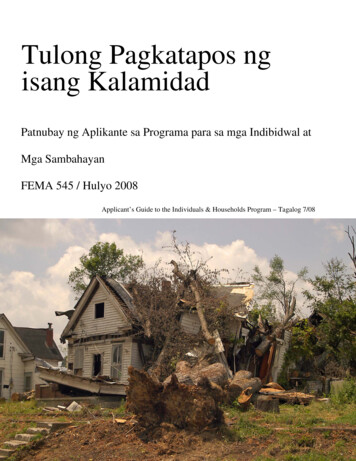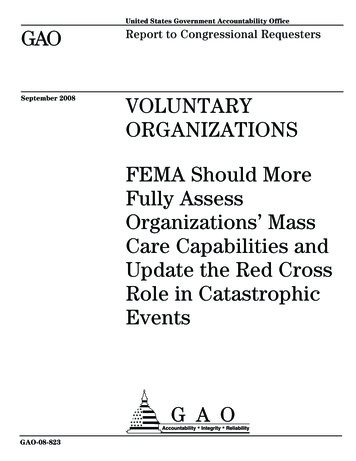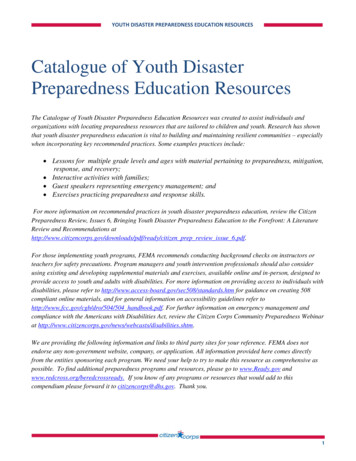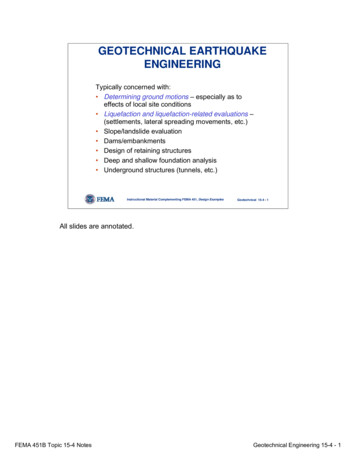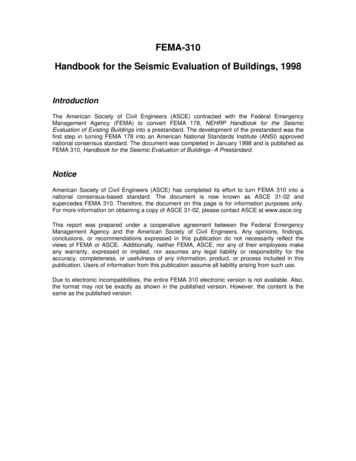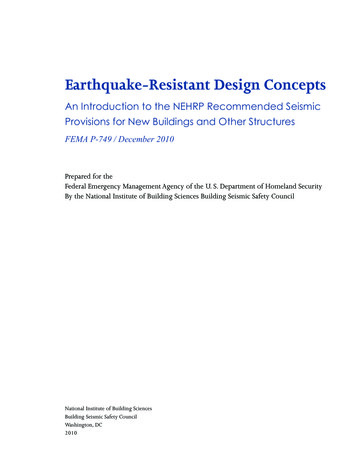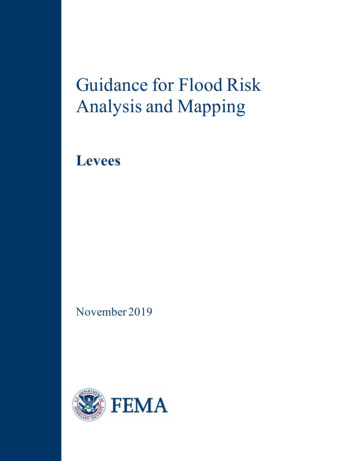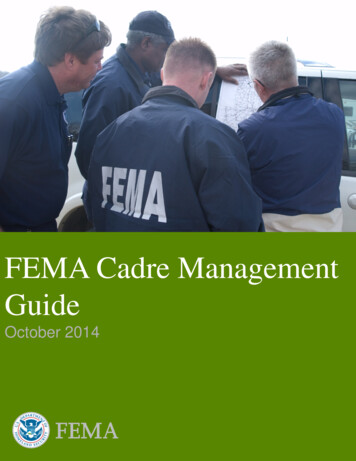
Transcription
FEMA Cadre ManagementGuideOctober 2014
.Table of ContentsChapter 1: Introduction . 1Authorities and Foundational Documents. 2Purpose and Scope . 3Chapter 2: The FEMA Cadre Management Framework. 4FEMA Cadres. 4Title V Employees (5 U.S. Code) . 4Stafford Act Employee . 5Cadre Management . 6Certifying Authority. 8Certifying Official. 8Cadre Coordinator. 9Cadre Training Manager . 10Reservist Program Manager. 11FTE Coordinator . 12IM CORE Program Manager . 12Regional Incident Workforce Management Liaison Team. 13Cadre Management Oversight. 15Incident Workforce Executive Steering Committee . 15Cadre Coordinators Working Group. 16Cadre Management Support. 17Incident Workforce Management Division . 17Office of Equal Rights . 18Office of the Chief Component Human Capital Officer. 19Office of the Chief Financial Officer. 19Office of the Chief Information Officer. 19Logistics Management Directorate . 20Office of the Chief Counsel . 20Chapter 3: Staffing Force Structure . 21Principles of FEMA’s Force Structure Model . 21i
.Staffing a Cadre. 22Force Structure versus Actuals Report . 22Filling Vacant Force Structure Positions . 24Interagency Augmentation to a Cadre’s Force Structure. 25Availability. 25Special Considerations for Managing Availability. 26Support to Cadres for Staffing Force Structure . 29Chapter 4: Educating and Training Members of a Cadre . 31Cadre Responsibilities in FQS . 32Types of Training . 34FEMA’s Training Philosophy . 35FEMA’s Training Mandate . 35Principles of Training. 35Train for Operations. 36Require Leadership Involvement and Ownership. 36Train to Standards . 36Use Performance-Oriented Training. 37Promote Team Operations . 37Challenge Employees. 37A Mission Essential Task List Approach to Cadre Training Development . 37Mission Essential Task List Fundamentals. 37Mission Essential Task List Development. 38Training Standards . 38Training Assessment. 38Required (FQS) Training . 39Enrollment for Scheduled FQS Courses . 40Mandatory Training. 41Programmatic Updates . 42Chapter 5: Qualifying Members of a Cadre. 43FQS Documentation. 43Revisions to FQS Documentation. 44ii
.Managing the Paperwork . 44Assignment of an Initial Position Title . 45Initial Assignment. 45Subordinates Titles. 48Issuance of Position Task Books. 49Issuance Policy. 49Position Task Book Issuance Form. 50Time Limits for Completion of PTBs. 50PTB Completion/Submission Process . 50Candidate Selection for Advancement. 50Certifying Qualification of a Position Title. 51Certification and Recertification Processes . 51Decertification Process . 52Reconsideration Process . 52Specialties. 52Chapter 6: Performance Management . 54Principles of Performance Management . 54Individual Incident Performance Evaluation. 54Chapter 7: Equipping Members of a Cadre . 56Principles for Equipping Members of a Cadre. 58Primary Responsibilities for Equipping a Cadre. 58Cadre Coordinators . 58Reservist Program Manager and IM CORE Program Manager . 59Office of the Chief Information Officer. 59Office of the Chief Security Officer . 60Incident Workforce Management Division . 60Federal Coordinating Officers . 60Logistics Management Directorate . 60Processes for Equipping Cadre Members . 61Information Technology Equipment. 61FEMA Branded Clothing . 63iii
.Government Issued Charge Card . 63Badging Information. 63Cadre Specific Equipment . 64Reasonable Accommodations. 64Support in Equipping a Cadre. 64Chapter 8: Cadre Readiness Assessment . 66Principles of Cadre Readiness Assessment. 66Readiness Scores. 67Assessment Methodology . 67Chapter 9: Communication and Coordination . 68Principles of Communication. 68Data Sharing. 68Cross Cadre Collaboration . 69Coordination/Communication with Cadre Members . 70Annual Individual Readiness Cadre Call. 70Quarterly Cadre Coordination Call. 71Annex 1: Acronyms . 73Annex 2: Glossary. 76Appendix A: Guidance for Working at the Residence of Record or at an Alternate Location whenon Temporary Duty. 80Appendix B: Systems Approach to Training . 83A Systems Approach to Training Management . 83System Phases. 84Appendix C: Entry Employee Request Form . 87Appendix D: QRB Employee Request Form. 89Appendix E: Transmittal Log Form. 92Appendix F: New Specialty Request Form . 93Appendix G: Processes for Assignment of a FQS Job Title. 94Initial Assignment . 94Reservist. 94IM CORE . 94iv
.FTE . 95Appendix H: PTB Issuance Form . 97Appendix I: Reservist Equipment Guidance. 98Malfunctioning Equipment Guidance for Reservists . 98Reservist at Home with Malfunctioning Equipment (Laptop) . 98Reservist at Home with Malfunctioning Equipment (Phone). 99Reservist at FEMA Location with Malfunctioning Equipment (Laptop, Phone). 99Appendix J: List and Description of FEMA Cadres. 100Purpose of Each Cadre . 101Appendix K: Positions and Responsibilities. 104Appendix L: Administrative Processes. 111Appendix M: Cadre Coordinator’s Resource List . 112Appendix N: Travel Authorization and Information Email Template. 113Appendix H: Staffing a Force Structure Vacancy . 115Appendix O: Certification/Decertification Process . 120Certification Process . 120Decertification Process. 121Appendix P: Cadre Coordinator Role in QRB Review . 123Appendix Q: Employee Self – Certification Health and Safety Checklist . 125Appendix R: Telework Application and Agreement . 126Appendix S: Workforce Analysis . 128Appendix T: Office of Chief Counsel. 129List of FiguresFigure 1: Cadre Management Structure. 8Figure 2: Regional Coordination Structure. 14Figure 3: Communication and Coordination among Cadre Management Elements . 17Figure 4: Process for Equipping a New Reservist and IM CORE: FIWA. 62Figure 5: Process for Equipping a New Reservist and IM CORE: Deployment to a JFO . 62Figure 6: Process for Equipping a New PFT and New CORE . 63Figure 7: Process for Equipment Replacement. 63v
.Figure 13: SAT Process . 84Figure 8: Staffing a Force Structure Vacancy for a FTE - Initial Assignment of Title, NonSupervisory . 115Figure 9: Staffing a Force Structure Vacancy for a FTE - Initial Assignment of Title, Supervisory. 116Figure 10: Staffing a Force Structure Vacancy for a FTE – Hiring. 117Figure 11: Staffing a Force Structure Vacancy for a Reservist - Hiring and Initial Assignment ofTitle . 118Figure 12: Staffing a Force Structure Vacancy for an IM CORE - Hiring and Initial Assignmentof Title. 119List of TablesTable 1: Positions and Responsibilities within Cadres . 7Table 2: Incident Workforce Executive Steering Committee Structure . 16Table 3: Cadre Coordinator Working Group Structure . 17Table 4: Example Force Structure vs. Actuals Report. 23Table 5: Hiring Process Steps . 24Table 6: Deployment Availability Requirements by Employee Type. 26Table 7: Staffing Force Structure Roles and Responsibilities . 29Table 8: Training Roles and Responsibilities . 32Table 9: Training Descriptions . 34Table 10: Initial Assignment of Title Process Step for FTE, Non-Supervisory . 47Table 11: Initial Assignment of Title Process Step for FTE, Supervisory . 48Table 12: Certification/Recertification Process . 51Table 13: Decertification Process . 52Table 14: FQS Support Roles . 53Table 15: Performance Management Support Roles . 55Table 16: Roles and Responsibilities for Equipping Cadre Members. 57Table 17: Cadre Equipping Support Roles . 65Table 19: FEMA Cadres . 100Table 18: Cadre Management Positions and Responsibilities. 104Table 20: Cadre Coordinator's Resource List . 1121vi
.CHAPTER 1: INTRODUCTIONThe Federal Emergency Management Agency’s (FEMA) workforce has one central goal – toensure the Agency builds, sustains, and continuously improves upon its capability to prepare for,protect against, respond to, recover from, and mitigate all hazards. During an incident, theAgency’s entire workforce supports this goal, despite their job series, grade, or employee type.To achieve this goal successfully, FEMA trains, qualifies, equips, and evaluates its workforce toprovide rapid, expeditionary support to fulfill statutory requirements. The incident workforce iscommitted to FEMA’s core values of compassion, fairness, integrity, and respect as outlined inFEMA Publication 1.FEMA actively engages in programs and partnerships to manage, enhance, augment, support,and deploy the Agency’s workforce. Overall management of the workforce requires an agencywide collaborative approach and clear definitions of roles and responsibilities to ensure thatFEMA is able to meet its statutory requirements.To ensure an effective and organized incident response, the workforce is categorized into fourcategories: Incident Management – positions at the incident level that support the Initial OperatingFacility, Joint Field Office (JFO), Area Field Office, or other locationsIncident Support – positions during incident operations at the regional or national level ineither the Regional Response Coordination Center (RRCC) or the National ResponseCoordination Center (NRCC)Ancillary Support – positions that, in both their steady-state and/or incident roles, supportthe NRCC and/or RRCC and incident field officesMission Essential – positions at headquarters, the regional offices, and other designatedoffices that must be filled to maintain basic Agency operations (e.g., payroll, informationtechnology, and maintenance). Mission essential functions must always be performed,but may require less than the full complement of staff at any one time. As a result,holding a mission essential function may not exclude an employee from deployment. TheEmergency Relocation Group is part of mission essential. Emergency Relocation Grouppersonnel report to a pre-selected continuity site to perform essential functions or othertasks related to continuity operationsBecause of what FEMA asks of its incident workforce, and what they will experience conductingresponse and recovery operations, it is imperative that they are fully supported in gaining andmaintaining optimum operational readiness. Operational readiness is how FEMA works toprepare their incident workforce for an activation and deployment. Readiness is achievedthrough a constant cycle of planning, equipping, training, exercising, monitoring, and evaluatingto ensure the workforce is ready at a moment’s notice. At FEMA, this is accomplished throughsound cadre management. FEMA’s incident workforce cadres are the initial operational1
.mechanism essential to maintain a supporting presence to both satisfy the Agency’s statutoryrequirements and honor its national commitments. As such, a standardized, agency-wide cadremanagement system is vital.Authorities and Foundational Documents Section 503(b) of the Homeland Security Act of 2002, Pub. L. No. 107-296 as amendedby the Post-Katrina Emergency Management Reform Act (PKEMRA), Pub. L. No. 109295 (Oct. 4, 2006) (codified at 6 U.S.C. § 313(b)(2)(C)) assigned FEMA the mission to“develop a Federal response capability that, when necessary and appropriate, can acteffectively and rapidly to deliver assistance essential to saving lives or protecting orpreserving property or public health and safety in a natural disaster, act of terrorism, orother man-made disaster.”Section 510 of the Homeland Security Act of 2002, Pub. L. No. 107-296, as amended byPKEMRA, Pub. L. No. 109-295 (codified at 6 U.S.C. § 320) requires that FEMAcollaborate with its emergency management partners to develop standards for deploymentcapabilities, including on credentialing of personnel and typing of resources necessary torespond to natural disasters, acts of terrorism, and other man-made disasters.FEMA Incident Management and Support Keystone, January 2011FEMA Incident Workforce Management Manual, working draft, March 10, 2014FEMA Qualification System Guide, October 3, 2012FEMA Directive FD010-6, Revision Number 01, FEMA Reservist Program, June 14,2012FEMA Directive FD010-7, National Incident Management Assistance Team (IMAT)Pilot Directive, April 19, 2013FEMA Directive FD010-8, FEMA Incident Workforce Deployment, January 29, 2014FEMA Directive FD010-9, Cadre Management Directive, June 9, 2014FEMA Directive FD119-7 REV: 02, Federal Personal Property Management, September24, 2013FEMA Manual 119-7-1, Federal Personal Property Management Manual, April 13, 2011FEMA Directive FD141-1, Records Management Program, March 6, 2014FEMA Manual 119-7-1, Federal Personal Property Management Manual, April 13, 2011FEMA Manual 123-9-1, FEMA Telework Policy, January 9, 2013FEMA Manual 1430.1, Reasonable Accommodations for the Federal EmergencyManagement Agency — Change 1, December 3, 2002“Compensation for FEMA Reservist Coordination and Training Requirements,” AssistantAdministrator for Response’s Memorandum, June 27, 20132
.Purpose and ScopeThe purpose of this guide is to describe the composition, governance, and principles of theFEMA cadre management system. It is specifically designed for FEMA Cadre Coordinators andtheir subordinate staff. It will expand upon the responsibilities outlined in the Cadre ManagementDirective, outlining resources, providing required information, and explaining processes andprocedures to successfully manage an operational incident workforce cadre. The scope of thisguide is limited to incident management positions.3
.CHAPTER 2: THE FEMA CADRE MANAGEMENTFRAMEWORKFEMA’s cadre management framework is designed to effectively maintain a cadre’s operationalreadiness on both the individual and collective level. Effective cadre management equates tooptimum operational readiness allowing the Agency to satisfy its requirements in the mitigation,response, and recovery mission areas.FEMA’s vision of a ready workforce is one that is adequately staffed, available, trained,qualified, and equipped to conduct its mission and is continuously monitored on performance toensure accountability in mission accomplishment and facilitate constant improvement. The cadremanagement framework detailed in this chapter provides organizational mechanisms for cadremanagement, oversight, and support. The framework underscores the importance that eachindividual employee increases our readiness and facilitates the execution of FEMA’s missions.FEMA CadresA cadre is defined as a group of FEMA full-time equivalent (FTE) and intermittent (Reservist)employees organized by operational or programmatic functions and are assigned incidentmanagement FEMA Qualification System (FQS) positions (either primary or subordinate) thatperform incident-related duties during FEMA incident operations. Cadres are groupedorganizationally by program area within corresponding directorates and offices throughout theAgency. A cadre is the operational mechanism the Agency maintains to effectively deliverFEMA programs in support of our National Preparedness Goal. These cadres are composed oftwo types of FEMA employees hired under Ti
Training Standards . Issuance of Position Task Books 49 . FEMA Directive FD119-7 REV: 02, Federal Personal Property Management, September 24, 2013 FEMA Manual 119-7-1, Federal Personal Property Management Manual, April 13, 2011
